Milan's pattern was born around the early 1800s, when a growing
number of manufacturers in the Lombard city issued once again the main kind of tarot known in Europe
by those times (Gumppenberg's luxury version shown in page I
is one of the most well-known examples). At first it remained rather faithful to the classic design, at the point that the early editions could have been almost carbon copies of the tarot of Marseille, had the names
of the trumps and courts been in French, instead of being spelt in Italian. Then, within the
time length of one century or even less, its graphic look was slightly simplified,
and lost some details peculiar of the southern French pattern
that had remained more or less unchanged since the early 1500s.
Most of the subjects shown in this page are samples taken from an early edition (c.1850)
and a late one (end of the same century), to illustrate both the differences between the
Milanese tarot and the "classic" one from Marseille, and how the former pattern developed in
its own geographic region.
|
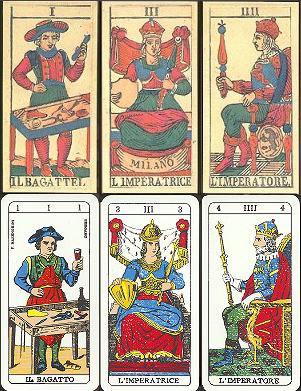
top row: T.Dotti's edition; bottom row: Masenghini's |
the Trivial Performer looks very much like the traditional conjurer, but his apron and
the tools in front of him (a shoe tree, pincers, a small hammer and a long needle), reveal that he was
turned into a shoe-maker, or maybe a shoe-repairing pedlar.
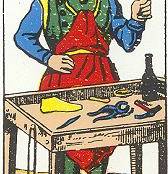
detail of the Trivial Performer's
shoemaker tools |
The Empress and the Emperor no longer feature the black
imperial eagle crest: their yellow shields are either blank (the Empress), or have
a different crest, often Milan's own, or have no shield at all.
In the Wheel of Fortune there are only two figures, an ascending one, in the shape of a fox,
and one on top, a crowned human with a sceptre; the third one, usually brought down
by the effects of ill-fortune, in Lombardy was dropped. |
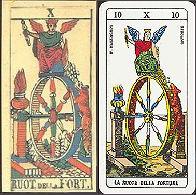
the Wheel of Fortune: note the
absence of the third figure |

Dotti's
Equality |

Masenghini's Intemperance |
Also trump no.XIII, Death, featuring the traditional
skeleton in the attitude of reaping lives with its scythe, is often left without a name
(see page I), and in Dotti's edition was even renamed Equality, with reference
to the common fate of mortals, the powerful and the commoners alike. Such changes were
probably due to the players' traditional dislike for details considered bringers of bad luck, thus
removed.
The central subjects of the set do not have many noticeable
details, but a funny mistake is found in no.XIV of some late 19h
and early 20th century editions (among which Masenghini's own): Temperance was turned
into ...Intemperance ! |
 |
|
A last remark is about the highest subjects of the set, from the Star
to the World. Since these cards are somewhat related to the heavens, in many late
editions the blank space above the illustration, i.e. the sky, was filled with colour: this
was blue in most cases, but yellow or tan in the Sun.
Furthermore, the two half-naked children in front of a brick wall (or stone wall) found
in Marseille's the Sun, in all Milanese editions grew up into a young man and woman,
duly clothed, while the wall is still there. |
|
the Sun and Judgement: note the coloured sky |
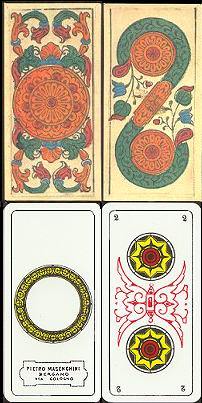 |
Also the suit cards were initially faithful to the model of Marseille, but kept gradually
shifting towards a more stylized design, quite simplified in the edition by Masenghini, one of the last ones that became available on the market. Among the most evident changes, the famous ace of Cups lost its typical late-medieval spires and hexagonal shape.
(left)
changes in the ace and 2 of Coins
(right)
samples from two mid-1800s editions:
ace of Coins by Edoardo Dotti,
and king of Batons by Teodoro Dotti |
The ace of Coins lost its central part, which became a blank
circle where to place the tax stamp, but in a few early editions the latter was placed
between the legs of the king of Batons (right); although the tax is no longer due, still
today this space is found in the Trentine pattern, see Regional Patterns,
Italian gallery, page 4). |

 |
Also the 2 of Coins (above) lost the S-shaped ribbon that wound around the two pips, and in Marseille's design usually bore the name of the manufacturer, which is now featured by the same card that carries the space for the tax stamp.
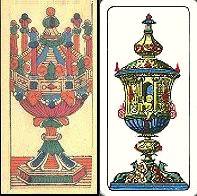
changes in the ace of Cups |
The suits of Swords and Batons remained basically faithful to
the classic ones (curved and straight, respectively), yet sometimes introducing innovative
designs, such as the peculiar 5 of Swords shown on the right, in which eight small sabres
are arranged so to suggest four long ones. |
Indices in roman numerals were still used in older editions, but they were slowly changed
into western ones, in some cases located in the corners.
Lastly, among the decorative details used for filling empty spaces, such as the central "hole"
in the 4 of Coins, curious finds are sometimes made: the one shown below, from T.Dotti's edition,
features a globe identical in shape to the one found in the World trump
belonging to the Flemish pattern, which had derived from the same card of the
Tarot de Paris (16th century), see the Flemish tarot
and the Tarot de Paris, respectively. |
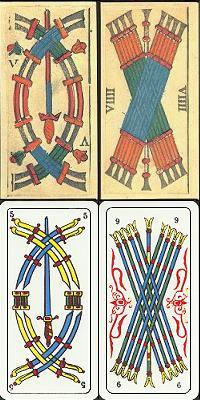
the evolution of Swords and Batons |
comparison of a few mid 1800s subjects (T.Dotti) with similar ones from the end of the same century (Masenghini)
TAROCCO PIEMONTESE
the cards shown in this paragraph are from the edition by Modiano (Italy)

(above) the Fool and the Conjurer |
Among the three regional tarot patterns still alive in Italy, the
Tarocco Piemontese (from Piedmont region) is probably the most common variety.
It consists of the traditional 78 cards, having sprung from the Tarot de Marseille,
though its illustrations have a rather naive appearance, and are double-headed.
|

the Chariot |
(below) the Hanged Man; the one on the
right is from Masenghini's edition
|
|
This is the only tarot with such feature, apparently insignificant, though
causing a complete loss of the details in the lower half of the illustrations;
for instance, we can no longer tell whether the Fool is still bitten by a
dog, nor how many personages turn around the Wheel of Fortune, nor whether Death is reaping
lives with its blade, and so on. The Tower features no human figures (which should
have been by its base), in the Moon the lake with a lobster in its
center remains unseen, and in the World only the two upper symbols of
the Tetramorph, the angel and the bull, are still visible, though repeated on
both ends of the card. |
In order to compensate this effect, in many trumps the proportions of important details,
such as
the Trivial Performer's table, or the horses of
the Chariot, or the
lion's head in
Strength, are deformed or reduced, so to fit at least partly
within the viewable part of the card, above the division line.
The most curious illustration is that of the Hanged Man (above), whose legs alone are seen from both ends of the trump. It is usually called l'Appeso in most Italian tarot editions (both regional and non-regional), but in the Piedmont tarot manufactured by Masenghini its name is still reminiscent of its French ancestor from Marseille (i.e. le Pendu), as it reads il Penduto.
Due to the double-headed scheme there are not many noticeable details in this pattern;
among the few is a butterfly that flies in the upper right corner of the Fool,
likely a symbol of carelessness and of freedom at the same time. Furthermore, subject no.17, is no longer the Star, but the Stars.
|
|
the Tower and the World |

ace of Cups |
In the Tarocco Piemontese the trumps feature
western numerals and, unlike most other tarot patterns, the Fool card too bears number 0, thus it officially
opens the 22-card series.
The suit cards are very similar to the original scheme, despite their
simplicity; for instance, the 2 of Coins and the 2 of Cups look like the ones
of any typical Marseille tarot. The only real alteration is that of the ace of Cups, which in Piedmont completely lost its ancient tabernacle-like vertical shape, turning into a large chalice, with a long stem, filled with flowers. |
|
ace of Coins and knave of Swords |
|
The courts, still faithful to the original model, became double-headed, and another slight difference is that their names, or ranks, are spelt vertically, except the ones of the knaves, which lack any lettering. |

(above) 2 of Cups and 2 of Coins |
Curiously, among the courts of Batons, the knave holds the same long and rough cudgel found in Marseille tarots, but most of its length is unseen, because below the illustration's doubling line. The cavalier of the same suit waves a much shorter club, the queen holds one with a smooth finish (as in Spanish cards), while the king instead of a cudgel has a mace.
Indices are present in most pip cards: Coins have them inside the same pips,
each of which is marked with the relevant Western numeral, while Cups have the
same kind of numerals in the corners of the card. The long suits, instead,
use roman numerals, located almost in the corners (Swords) or centrally (Batons). |
(below) knave and king of Batons
 |